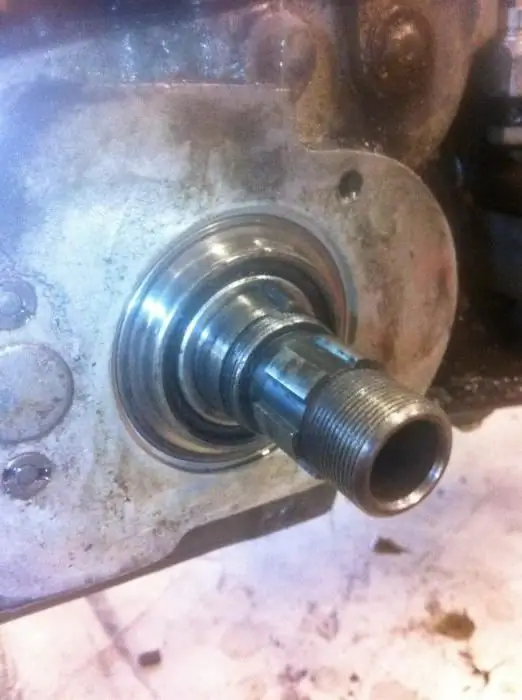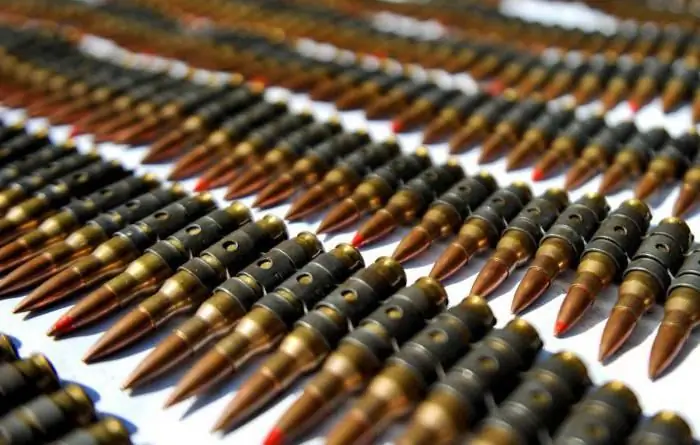2025 Author: Howard Calhoun | [email protected]. Last modified: 2025-01-24 13:10:26
The rate of fire of weapons in a certain period of time largely depends on the ammunition. The belt feeding system makes it possible to increase the practical rate of fire of small arms, allowing continuous fire for a long time. Such a system is mainly used for combat power for machine guns, less often for grenade launchers and automatic guns. Hence the belt loaded with cartridges got its name - machine gun belt.

Cartridge belt feeding system
In addition to the undeniable advantages of tape feeding cartridges, this system also has disadvantages, namely: to a certain extent, there is a deterioration in maneuverability due to an increase in the mass and dimensions of the weapon. In this regard, the most effective areas of application for belt feed were determined: heavy machine gun, large-caliber infantry, tank, anti-aircraft and aircraft machine guns, automatic grenade launchers, small-caliber guns. In modern light machine guns, this system is used in combination with a magazine.
The main elements of the system are: a cartridge belt (machine gun) - a belt with slots for cartridges, and a mechanism for feeding it to the reloading line, which consists of a movement mechanism and a movement drive. The essence of the tape system isin the automatic movement of the tape loaded with cartridges with each shot by the movement mechanism by one step, which is equal to the gap between adjacent cartridges. The smaller the movement step, the less energy is required to feed the machine-gun belt. This increases the reliability of the feed mechanism, allows you to make the tape more compact, which reduces the "dead" weight and increases the overall maneuverability of the weapon. At the same time, this reduces the flexibility of the tape, which can affect the size of the cartridge case.

Assignment of machine-gun belt
Machine-gun belt is used to place cartridges on it with a certain interval from each other. The feed of the tape for moving the cartridge into the chamber is carried out by a mechanism that is driven by the energy of the moving parts of the weapon, while the next cartridge is in a strictly set position (step) for the next stage of supply.
Cartridge belt has a lower "dead" weight than a gun magazine, that is, the mass of an empty belt is less than the mass of empty magazines in the calculation for an equal number of cartridges. At present, with ever-increasing requirements for the intensity and duration of firing, as well as an increase in the maneuverability of weapons, belt feed systems are increasingly used in large-caliber, heavy and light machine guns. Due to the presence of a number of shortcomings that create some inconvenience during operation, work is constantly being carried out to improve machine-gun belts that require more complex design.

A bit of history
One of the first unitary cartridge belt feed systems was used in the hand-operated Bailey machine gun. This fixed bolt and rotating barrel system was patented in 1876. The machine-gun belt used in the Bailey system was a canvas strip with L-shaped metal squares sewn on. Holders of tubular cartridges were attached to the squares. After the shot, the cartridge case remained in the tape.
Although still experimental, Bailey's system was not widely used. The first truly mass model was the machine gun of the Maxim system. The tape for this weapon was as simple as possible in design and was an elongated version of the bandolier belt. Two canvas strips were sewn together, forming through, equal-pitch cartridge pockets.

Views
In practice, there are two main types of machine-gun belts: flexible and rigid. The first, in turn, are divided into soft, semi-rigid and combined. Machine-gun belt can be made of canvas or cotton, spring steel, plastic. The most common material for modern cartridge belts is steel, as it is the least affected by atmospheric conditions.
According to the way the links are connected, there are two types of metal tapes: with split links and fixed length. In a detachable tape, the individual links are combined by the cartridges themselves when it is equipped. During the shooting,ejection of the spent connecting sleeve, the links crumble. Such tapes are not limited in length, have a small pitch and are easy to handle, for example, in cramped conditions of infantry fighting vehicles and armored personnel carriers.
Fixed length tapes are used in field systems. Their one-piece links fit together, eliminating separation during operation, allowing their use for re-equipment. These are reusable tapes. Machine-gun belt 7, 62 mm of fixed length is used in Goryunov machine guns and Kalashnikov uniform machine guns. The capacity of such tapes is from 50 to 250 rounds.
Rigid cartridge belt - a metal strip with cartridge slots stamped into it. Rigid tape has no advantages other than the simplicity of the device. Their capacity is extremely small. Used in heavy machine guns, such as the Hotchkiss system.

Basic requirements for machine gun belts
During the operation of automatic weapons, the machine-gun belt is subjected to jerks and significant efforts. Therefore, one of the main requirements for the tape is its strength. It is due to the large service loads in the operation of weapons and their transportation.
During the operation of automation, the cartridge supplied to the receiver must be in a strictly designated position. This will eliminate distortions and, as a result, delays in firing. The fixation of the cartridge in the tape must be reliable in a certain position and not be disturbed by shaking during shooting or transportation. However, the force required toremoval of the cartridge from the latch, should not be excessively large for the normal operation of the automatic weapon.
Link device
Any machine-gun belt always has devices for fixing the cartridge and its alignment. In metal belts, fixation and alignment of the cartridge is carried out by one part of the link at the same time. For this purpose, the limbs of the link are used, into which the sleeve rests with the bottom, or the protrusions (tails) of the link that fall into the groove of the sleeve. Fixation can also be provided by a stop of the sleeve slope against the inner surface of the link slope. In canvas belts, the alignment of the cartridges was carried out using every tenth metal separator plate, which was made longer and protruded beyond the canvas strip. Fixation, as well as alignment, was achieved due to the canvas fold on the muzzle of the sleeve.

Famous machine guns of World War II
Even at the beginning of the twentieth century, machine guns were considered as a special type of weapon with a narrow range of combat missions. By the middle of the century, this type of weapon was considered one of the most important means of combat operations at short and medium distances. The revision of the significance of this weapon fell on the Second World War, it was during this period that some samples of machine guns became legendary and prototypes for future developments. The most famous machine guns of World War II that used a belt feeding system are listed below:
- Single machine gun MG 42. German machine gun MG 42 7, 92 mm Mauser (short for Maschinengewehr, which is translated"mechanical rifle"), was adopted by the Wehrmacht in 1942. According to most weapons experts, it is considered the best machine gun of its time. It was notable for its simplicity, convenience, durability, reliability, and, most importantly, incomparable rate of fire.
- Legendary machine gun 7.62 mm "Maxim" model 1941 with an enlarged neck of the cooling jacket. In the field, even snow was used to cool the barrel.
- 7, 62 mm Goryunov SG-43 heavy machine gun. Designed and put into service in 1943 as a replacement for the Maxim and the Degtyarev DS-39 machine gun.
Loading machine-gun belt
The equipment of the tape can also be carried out manually, there is even a specific standard for this. But with a large amount of ammunition, a special machine is used to load machine-gun belts. A device for loading cartridge belts designed by Rakov is known. This machine, designed for 7.62 mm cartridges, consists of several key parts: a hopper, a moving bottom, a tape clamp, a sorter with a collar, a feeder, a crank handle, a panel, a clamp, a rammer, and a tape stop. The bunker is filled with cartridges so that they are located across it. The cover of the receiver opens, the tape is inserted with links down. The first cartridge is inserted into the link manually, the tape is laid by the cartridge against the rammer. For loading, the handle rotates evenly clockwise, while adding cartridges to the hopper and making sure that the belt does not twist when loaded.
When manually loading the tape, it is placed onthe palm of the left hand with the tip towards itself and adheres to the thumb. Cartridges are picked up with the right hand and links are inserted so that the limiting ledge enters the annular groove of the cartridge. It is strictly forbidden to equip the tape through one link, which can lead to breakage of the links, as well as to use damaged cartridges.

Cartridge boxes
For ease of use and transportation, equipped belts are placed in special boxes for machine-gun belt:
- Cylindrical (RPD machine guns) in which the tape is rolled up. When the tape moves, during shooting, the entire roll rotates, which consumes significant energy of the weapon.
- Rectangular (PK/PKM, KPV, NSV "Utes" machine guns). The tape is laid across the box in rows. The feed mechanism only moves the top row in the box and the hanging portion of the ribbon.
Rectangular cartridge cases are most widely used in modern models of automatic weapons. Their dimensions depend on the type and number of cartridges in the tape. Cartridge boxes for machine guns using cartridges of the same type (for example, PK, SGM, PKT - rifle 7, 62 mm) are interchangeable. The capacity of standard ammo boxes is 100, 200 or 250 rounds, for tank machine guns higher capacity boxes are provided.
Recommended:
Toothed belt. Timing belt profiles

The belt drive, which uses a toothed belt, is one of the oldest mechanical inventions. However, despite the fact that this transmission method was invented a very long time ago, it is actively used at the present time
Conveyor belts: overview, description, types. Rubber conveyor belt

Conveyor belts are one of the most common and convenient means for moving a product from one point to another. They are used in many industries, ranging from household industry to heavy engineering
Belt conveyor: work, scheme and device. Operation of belt conveyors

Today it is difficult to imagine high-performance production without the use of a conveyor. To move goods, including bulk, use closed belts. We can say that this is a continuous unit, which has a load-bearing body (flexible tape). Let's take a closer look at what a belt conveyor is, what is its purpose, scope, and also what are the subtleties of operating this equipment
Connections: purpose, types of connections. Examples, advantages, disadvantages of types of compounds

Machines and machine tools, equipment and household appliances - all these mechanisms have many details in their design. Their high-quality connection is a guarantee of reliability and safety during work. What types of connections are there? Let's take a closer look at their characteristics, advantages and disadvantages
Charging property tax: postings in accounting

The formation of budgets at various levels is due to the collection by the state of a part of the income of organizations and its redistribution. Tax payments of a particular business entity depend on many factors: the direction of work, the chosen mode, the availability of a settlement base, etc

